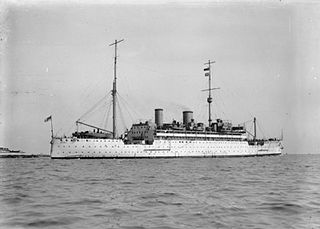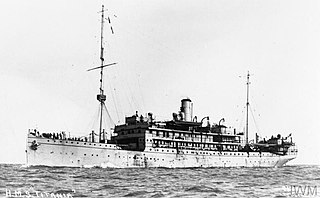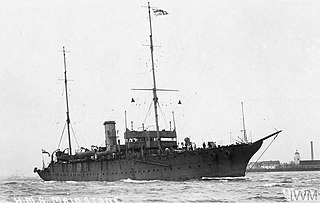
HMS Sidon was a submarine of the Royal Navy, launched in September 1944, one of the third group of S class built by Cammell Laird & Co Limited, Birkenhead, named after the naval bombardment of Sidon in 1840. An explosion caused by a faulty torpedo sank her in Portland Harbour with the loss of 13 lives.

The Commander-in-Chief Fleet (CINCFLEET) was the admiral responsible for the operations of the ships, submarines and aircraft of the British Royal Navy from 1971 until April 2012. The post was subordinate to the First Sea Lord, the professional head of the Naval Service. In its last years, as the Navy shrank, more administrative responsibilities were added.

HMS Bat was a Palmer-built three funnel, 30 knot torpedo boat destroyer ordered by the Royal Navy under the 1895 – 1896 Naval Estimates. She was the third ship to carry this name since it was introduced in 1815 for a revenue cutter in service until 1848. Bat was classified along with similar vessels as a C-class destroyer in 1913.

HMS Caroline is a decommissioned C-class light cruiser of the Royal Navy that saw combat service in the First World War and served as an administrative centre in the Second World War. Caroline was launched and commissioned in 1914. At the time of her decommissioning in 2011 she was the second-oldest ship in Royal Navy service, after HMS Victory. She served as a static headquarters and training ship for the Royal Naval Reserve, based in Alexandra Dock, Belfast, Northern Ireland, for the later stages of her career. She was converted into a museum ship. From October 2016 she underwent inspection and repairs to her hull at Harland and Wolff and opened to the public on 1 July 2017 at Alexandra Dock in the Titanic Quarter in Belfast.

HMS Medway was the first purpose-built submarine depot ship constructed for the Royal Navy. She was built by Vickers Armstrong at Barrow-in-Furness during the late 1920s. The ship served on the China Station before the Second World War and was transferred to Egypt in early 1940. Ordered to evacuate Alexandria in the face of the German advance after the Battle of Gazala in May 1942, Medway sailed for Lebanon at the end of June, escorted by a light cruiser and seven destroyers. Her strong escort could not protect her; on 30 June a German submarine torpedoed and sank her.

A depot ship is an auxiliary ship used as a mobile or fixed base for submarines, destroyers, minesweepers, fast attack craft, landing craft, or other small ships with similarly limited space for maintenance equipment and crew dining, berthing and relaxation. Depot ships may be identified as tenders in American English. Depot ships may be specifically designed for their purpose or be converted from another purpose.
HMS D3 was a D-class submarine of the British Royal Navy, one of eight of this class. D3 was built by Vickers at their Barrow-in-Furness works in 1910–1911, being launched on 17 October 1910 and completed on 30 August 1911.

The British campaign in the Baltic 1918–1919 was a part of the Allied intervention in the Russian Civil War. The codename of the Royal Navy campaign was Operation Red Trek. The intervention played a key role in enabling the establishment of the independent states of Estonia and Latvia. It failed to secure the control of Petrograd by White Russian forces, which was one of the main goals of the campaign.

HMS Zephyr was one of two Fervent-class destroyers which served with the Royal Navy. She was launched on 10 May 1895 from Hanna, Donald & Wilson at Paisley, Scotland. She served in home waters, and was sold in 1920.

HMS Boyne was a Hawthorn Leslie type River-class destroyer ordered by the Royal Navy under the 1903 – 1904 Naval Estimates. Named after the River Boyne in Ireland, the site of a British military victory in 1689, she was the fifth ship to carry this name since it was introduced in 1692 for a two deck ship-of-the-line.

HMS Porcupine was a P-class destroyer built by Vickers Armstrong on the River Tyne. She was ordered on 20 October 1939, laid down on 26 December 1939 and launched on 10 June 1941. She was commissioned on 31 August 1942, but had a relatively short active career. She was torpedoed in 1942 but salvaged and not finally broken up until 1947.

HMS Venomous (ex-Venom), was a Modified W-class destroyer of the British Royal Navy that saw service in the Russian Civil War and World War II.

HMS Cherwell was a Palmer Type River-class destroyer ordered by the Royal Navy under the 1902 – 1903 Naval Estimates. Named after the River Cherwell in south central England near Oxford, she was the first ship to carry this name in the Royal Navy.

HMS Exe was a River-class destroyer ordered by the Royal Navy under the 1901–1902 Naval Estimates. Named after the River Exe in southern England flowing through Exeter in the County of Devon, she was the first ship to carry this name in the Royal Navy. She served on the China Station before World War I and in the North Sea during the war. She was sold in 1920.

HMS Recruit was a Clydebank three-funnel, 30-knot destroyer ordered by the Royal Navy under the 1895–1896 Naval Estimates. She was the fifth ship to carry this name since it was introduced in 1806 for an 18-gun brig-sloop, sold in 1822.

HMS Cyclops (F31) was a submarine repair and depot ship of the Royal Navy. She was originally the passenger liner Indrabarah sister ship to Indralema, built by Laing, for the Indra Line Ltd then bought by The Admiralty, while she was building. She was launched on 27 October 1905.
In 1989 the Royal Navy was under the direction of the Navy Department in the UK Ministry of Defence. It had two main commands, CINCFLEET and Naval Home Command.

HMS Titania was a Royal Navy submarine depot ship. Most of those that saw service in the First World War were scrapped in the 1930s. Titania, however, saw service in the Second World War. She was scrapped at Faslane, Scotland, in September 1949.
The 8th Submarine Flotilla was a flotilla of the British Royal Navy consisting of submarines and their supporting depot ships and destroyers. It was established as part of the Home Fleet in 1912. The flotilla brought together the newer, longer range 'overseas' submarines for the purpose of carrying out offensive operations. Composition of the flotilla varied over time. It was disestablished in 1919.

HMS Maidstone was a submarine depot ship of the Royal Navy. She was purpose built to support 12 of the new 'D' Class submarines under the 1910/11 Naval Programme.



















